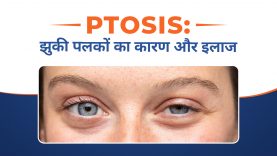Ptosis (Droopy Eyelid): Causes, Symptoms & Treatment | पलकों के गिरने का क्या कारण है? | झुकी हुई पलकों को कैसे ठीक करें?
- 7.77K
- 1 year ago
Dr. Anin Sethi
Dr. Anin Sethi
Ptosis (Droopy Eyelid): Causes, Symptoms & Treatment | पलकों के गिरने का क्या कारण है? | झुकी हुई पलकों को कैसे ठीक करें? |
Ptosis (Droopy Eyelid) In this video, Dr. Anin Sethi from Mirchia’s Laser Eye Clinic: A unit of Dr Agarwals Eye Hospital, discusses the causes and treatment of Ptosis or drooping of the eyelid.
What is Ptosis?
It is an eye condition when the eyelids are unable to open completely. It is a medical term called Ptosis (Droopy Eyelid). Ptosis may occur in single or both eyelashes. In this condition, the patient cannot open their eyes completely. Its prevalence is in younger children or the older age group above 60-70. In both age groups, the cause of Ptosis is different.
Causes of Ptosis in Children and Elderly Population :
In younger children, there is impairment in the muscles responsible for eyelid movement, or they may even have an improper nerve supply, due to which they cannot open the eyelashes entirely. It may occur in different degrees. It can be mild in a few cases, but it may get so severe that eyelashes fully cover the eyeball. This results in a non-functional eye.
In younger children, there is impairment in the muscles responsible for eyelid movement, or they may even have an improper nerve supply, due to which they cannot open the eyelashes entirely. It may occur in different degrees. It can be mild in a few cases, but it may get so severe that eyelashes fully cover the eyeball. This results in a non-functional eye.
The second age is the old age group, in which the muscle responsible for eyelash movements weakens after 60 – 70 years of age. Subsequently, their attachment also weakens, and the detachment of the muscles from the eyelashes often results in eyelids drool. As a result, they are unable to move upwards. Apart from these, there are other bodily conditions, like Myasthenia gravis, in which the body’s muscle starts weakening. It is more likely to progress in a day; in the morning, Ptosis is not present in the eye, but as the day continues, the muscles weaken, and eyelids start drooping. In addition, the oculomotor nerve, or the third cranial nerve, also connects the eyes with the brain. Therefore, a third cranial nerve disease may also cause eyelids and movement dysfunction.
Furthermore, it may cause paralysis causing eyelids to droop. Another reason is facial nerve palsy which controls facial muscles. So all muscles around the eyelashes weaken, failing to open the eyelid.
Can Ptosis be an indication of any serious underlying condition?
Yes, it can be, especially when it is a sudden onset or has occurred recently. Sudden occurrences indicate neurological problems. The third cranial nerve palsy occurs for many reasons and is related to the brain. Hence doctors need to evaluate these patients thoroughly for any neurological condition. If it is old age, if it has occurred suddenly, and there is a restriction in eye movement; it is very important to discuss it with a neurologist, and sometimes one may need MRI imaging. So observing these symptoms, one can infer that it might indicate any serious underlying disease in a few patients.
But if in children ptosis condition is congenital or it has started progressing slowly, then they are not potential indicators of any diseases. The second reason is Myasthenia gravis, in which eyelids don’t droop in the morning but start drooping over the day. Under these circumstances, it is very important to consult a neurologist, as they might suggest a few tests to diagnose this condition more accurately.
Treatment:
Ptosis treatment depends on the underlying causes. If it has occurred due to cranial nerve palsy, doctors ideally observe it for 4-6 months. In most cases, it self-heals. But if that’s not the case and it is congenital or has occurred due to weak muscles, one might need surgical help. In children, if Ptosis affects their eyesight, then only doctors suggest treatment. Suppose the eyelids entirely cover the entire eye and affect their vision. In that case, they require surgery because, in these cases, the eyesight doesn’t develop properly, resulting in lazy eyes. But if the child is very young, but their eyes are open, not entirely closed, then under these circumstances, one can postpone the surgery.
In the elderly population in which eyelids droop over due to muscle weakening, surgical treatment is the best option. But if it’s not an operable case, then certain specs with clips attached keep the eyelids open. So the main thing is that its treatment is surgical only. In minor instances, Ptosis is minimal surgery, but the type of surgery depends upon the severity of Ptosis. Suppose it is very severe, resulting in complete dysfunction of eyelid muscles. In that case, doctors do sling surgery in which they implant a silicone sling beneath the skin, which helps open the eyelid. You need to consult your ophthalmologist for different types of surgery.
Is there any exercise that helps in the treatment of drooping eyelids?
So there isn’t any exercise that may help improve this condition. Further, it depends upon the cause. Observation is key to treatment if it has occurred due to any nerve palsy. If it heals on its own, then well; otherwise, surgical treatment is the only option. But, there isn’t any exercise that can help improve the eyelid condition.
For more information about the causes and treatment of eye diseases like ptosis , visit our SimpliHealth website.














Comments (0)